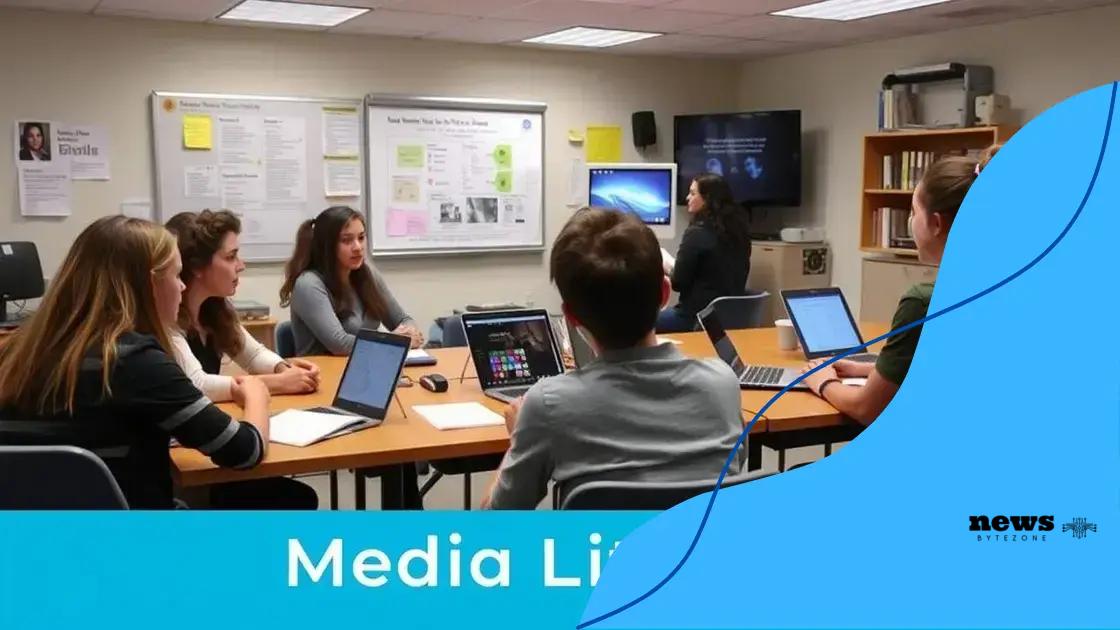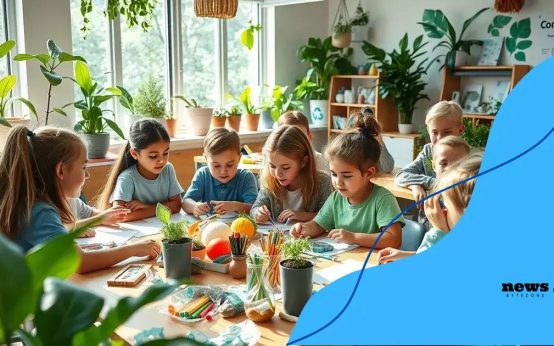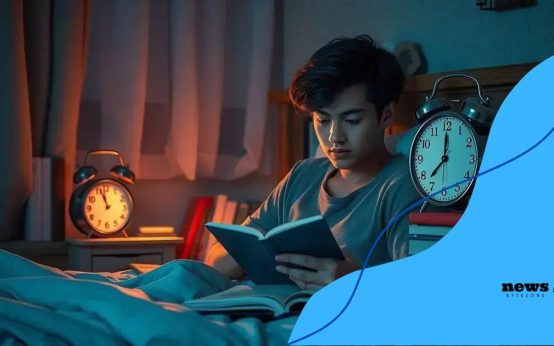The importance of media literacy in the digital age lies in its ability to equip individuals with the skills to critically analyze information, recognize misinformation, and make informed decisions.
The importance of media literacy in the digital age cannot be overstated. With a flood of information at our fingertips, knowing how to discern credible sources is essential. So, how can we equip ourselves to navigate this complex landscape?
Understanding media literacy
Understanding media literacy is essential in our digital world. It allows individuals to critically analyze the flood of information presented to them. As we encounter various forms of media, knowing how to interpret and evaluate these messages is vital.
What is Media Literacy?
Media literacy refers to the ability to access, analyze, evaluate, and create media in various forms. It’s about developing skills to understand the role that media plays in society and how it influences our beliefs and actions. This understanding helps individuals become more informed citizens.
Key Components of Media Literacy
- Critical Thinking: Individuals learn to question the information they receive.
- Analysis Skills: Evaluating content to discern fact from opinion.
- Technical Proficiency: Understanding how to use digital tools effectively.
- Ethical Considerations: Recognizing the impact of media on society.
Incorporating media literacy into education is vital. It prepares students to navigate the complexities of modern media landscapes. By fostering critical discussions and promoting analytical skills, teachers can empower students to question sources and verify facts.
Moreover, as technology evolves, media literacy education must adapt. New platforms and distribution methods require individuals to stay informed about how information spreads. This dynamic nature of media necessitates ongoing learning.
The Benefits of Being Media Literate
Being media literate has numerous benefits. It enables individuals to recognize bias and propaganda. More importantly, it equips them with tools to seek out diverse perspectives and make informed decisions.
In today’s world, misinformation can easily spread. Thus, media literacy becomes a shield against such pitfalls. It’s not just about consuming media but also about participating responsibly in discussions.
The impact of misinformation
The impact of misinformation on society is profound and far-reaching. As people consume information daily, distinguishing fact from fiction has become increasingly challenging. Understanding how misinformation spreads is crucial for everyone.
How Misinformation Spreads
Misinformation travels quickly through various channels, especially social media. When people share unverified news articles or sensational stories, it creates a ripple effect. This can lead to widespread beliefs in false information.
- Social Media Algorithms: These algorithms often promote content that engages users, regardless of its accuracy.
- Emotional Appeal: Stories that evoke strong emotions are more likely to be shared.
- Lack of Critical Thinking: Many individuals accept information without questioning its validity.
In addition to spreading rapidly, misinformation can have serious consequences. It can alter public opinion, influence elections, and even affect health outcomes. The COVID-19 pandemic illustrated how damaging misinformation about vaccines and treatment options could be.
Consequences of Misinformation
The consequences vary, affecting individuals and communities alike. Misinformation can lead to panic, confusion, and poor decision-making. For instance, during crises, false information can lead to dangerous behaviors or hinder effective responses.
Moreover, the long-term damage can be significant. Trust in media can erode as people become skeptical of all information, even credible sources. When misinformation prevails, it creates a culture of doubt that can harm democratic processes and informed discussions.
To combat this, it is essential to promote media literacy. Teaching individuals how to critically evaluate information helps them identify misinformation and its sources. This way, they can make informed choices, reducing the influence of false narratives.
Strategies for enhancing media literacy

Enhancing media literacy is vital in today’s information-saturated world. By developing skills to critically engage with media, individuals can better navigate the challenges posed by misinformation.
Developing Critical Thinking Skills
One effective strategy is to foster critical thinking. This involves encouraging individuals to question the sources of information they encounter. Asking who created the content and why it was produced helps build a healthy skepticism.
Engaging in Discussions
Engaging in discussions about media is another way to boost media literacy. Conversations in classrooms or community groups create opportunities for people to share their perspectives. This sharing enhances understanding and encourages multiple viewpoints.
- Debates: Hosting debates on current events helps participants articulate their thoughts and consider opposing views.
- Workshops: Organizing workshops focused on evaluating news sources can be very beneficial.
- Group Activities: Collaborating on projects related to media can foster teamwork and critical analysis.
Additionally, promoting diverse media consumption is essential. By exploring various formats, including news articles, podcasts, and documentaries, individuals can learn to recognize bias and develop a more rounded perspective.
Being aware of one’s own biases also plays a significant role. Individuals should reflect on their views and how these shape their perceptions of media. This self-awareness helps to combat the influence of confirmation bias. Acknowledging that we all have tendencies to favor information that aligns with our beliefs can lead to more open-minded engagement with different sources.
Implementing Media Literacy Education
Implementing media literacy education in schools can significantly enhance students’ abilities. Curriculum that includes lessons on identifying credible sources, analyzing media content, and understanding the impact of misinformation is crucial.
Teachers can utilize real-world examples to illustrate how media can influence public perception. This practical approach helps students relate to the content and see its relevance in their lives.
The role of education in media literacy
The role of education in media literacy is essential for fostering informed and critical thinkers in society. By integrating media literacy into educational settings, we equip students with the tools necessary to navigate the complex media landscape they encounter daily.
Integrating Media Literacy in Curriculum
Incorporating media literacy lessons into the curriculum helps students learn to analyze information critically. This integration can occur across various subjects, including language arts, social studies, and science. Through these lessons, students can develop skills to recognize bias, evaluate sources, and create their own media content.
Encouraging Critical Thinking
Encouraging critical thinking is pivotal in teaching media literacy. Educators can foster an environment where questioning and analysis are valued. Assignments that involve comparing news articles or analyzing advertisements can stimulate discussions and deepen students’ understanding of media messages.
- Real-World Examples: Using current events or popular media allows students to connect lessons to their everyday lives.
- Group Discussions: Encouraging students to share their views on media helps them understand diverse perspectives.
- Hands-On Projects: Creating news articles or video projects allows students to apply their knowledge in practical ways.
Moreover, teacher training is crucial. Educators need to be well-versed in media literacy principles. Professional development opportunities can help them stay updated on trends and effective teaching strategies. When teachers are confident in their skills, they can inspire their students to engage critically with media.
Parents also play a vital role in fostering media literacy. Schools can collaborate with families by offering workshops that teach parents and caregivers how to discuss media with their children. This partnership ensures that the lessons learned in school can be reinforced at home.
Cultivating Lifelong Skills
Ultimately, the goal of education around media literacy is to cultivate lifelong skills. As technology evolves, the ability to discern credible information becomes even more crucial. Students who gain these skills in school are better prepared to navigate the information they encounter throughout their lives.
Future trends in media engagement
Future trends in media engagement promise to shape how we interact with information. As technology evolves, so do the ways we consume and engage with media content.
Increased Personalization
One significant trend is the move toward increased personalization. Media platforms are using algorithms to tailor content to individual preferences. This means users will see more of what they like, but it also raises concerns about exposure to diverse viewpoints.
Interactive Content
Another trend is the growth of interactive content. Users are no longer passive recipients of information; they want to engage actively. Quizzes, polls, and interactive videos are becoming popular and allow audiences to participate in the storytelling process.
- Gamification: Elements of game design are being integrated into media to make learning more enjoyable.
- Augmented Reality (AR): AR is being used for immersive experiences, allowing users to interact with content in real-time.
- User-Generated Content: Audiences are encouraged to create and share their own media, blurring the lines between creators and consumers.
Moreover, the rise of social media platforms has transformed how news is disseminated. Shorter attention spans require media outlets to adapt their approaches. Bite-sized content is trending, as it is easier to consume quickly.
Focus on Authenticity
As audiences become more discerning, the demand for authenticity in media is growing. People are seeking trustworthy sources and genuine representations of events. This shift encourages creators to prioritize accuracy and integrity in their content.
Additionally, with the advent of deepfakes and other technologies that can manipulate media, critical thinking skills are more important than ever. People will need to question the reality of what they see and hear.
As media engagement continues to evolve, educational initiatives that teach media literacy will become increasingly essential. Equipping individuals with the skills to navigate this landscape will ensure they can discern truthful information in a sea of content.
FAQ – Frequently Asked Questions about Media Literacy
What is media literacy?
Media literacy is the ability to access, analyze, evaluate, and create media in various forms, helping individuals critically engage with information.
Why is media literacy important in the digital age?
In the digital age, media literacy is vital because it helps individuals discern credible information from misinformation, enhancing informed decision-making.
How can education enhance media literacy?
Education can enhance media literacy by integrating it into the curriculum, promoting critical thinking, and encouraging discussions about media content.
What role do parents play in promoting media literacy?
Parents can promote media literacy by engaging in discussions about media with their children and supporting educational initiatives that teach critical evaluation of content.

 Environmental education: integrating sustainability into curricula
Environmental education: integrating sustainability into curricula  The impact of sleep on student performance and well-being
The impact of sleep on student performance and well-being  Coding bootcamps vs. traditional degrees: what’s right for you?
Coding bootcamps vs. traditional degrees: what’s right for you?